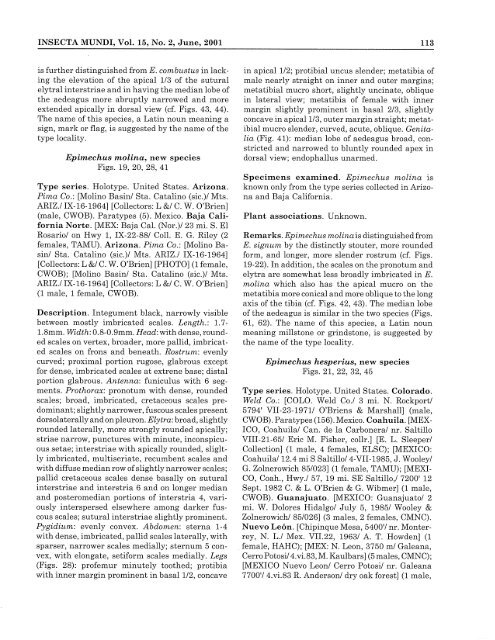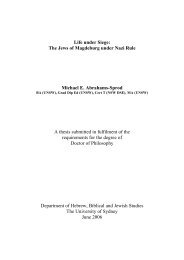Epimechus Dietz (Coleoptera: Curculionidae: Anthonomini)
Epimechus Dietz (Coleoptera: Curculionidae: Anthonomini)
Epimechus Dietz (Coleoptera: Curculionidae: Anthonomini)
You also want an ePaper? Increase the reach of your titles
YUMPU automatically turns print PDFs into web optimized ePapers that Google loves.
INSECTA MUNDI, Vol. 15, No.2, June, 2001<br />
is further distinguished from E. combustus in lacking<br />
the elevation of the apical 113 of the sutural<br />
elytral interstriae and in having the median lobe of<br />
the aedeagus more abruptly narrowed and more<br />
extended apically in dorsal view (cf. Figs. 43, 44).<br />
The name of this species, a Latin noun meaning a<br />
sign, mark or flag, is suggested by the name of the<br />
type locality.<br />
<strong>Epimechus</strong> molina, new species<br />
Figs. 19, 20, 28, 41<br />
Type series. Holotype. United States. Arizona.<br />
Pima Co.: [Molino Basin/ Sta. Catalino (sic.)/ Mts.<br />
ARIZ.! IX-16-1964] [Collectors: L &/ C. W. O'Brien]<br />
(male, CWO B). Paratypes (5). Mexico. Baja California<br />
Norte. [MEX: Baja Cal. (Nor.)/ 23 mi. S. El<br />
Rosario/ on Hwy 1, IX-22-88/ ColI. E. G. Riley (2<br />
females, TAMU). Arizona. Pima Co.: [Molino Basin/<br />
Sta. Catalino (sic.)/ Mts. ARIZ.! IX-16-1964]<br />
[Collectors: L &/ C. W. O'Brien] [PHOTO] (1 female,<br />
CWOB); [Molino Basin/ Sta. Catalino (sic.)/ Mts.<br />
ARIZ.! IX-16-1964] [Collectors: L &/ C. W. O'Brien]<br />
(1 male, 1 female, CWOB).<br />
Description. Integument black, narrowly visible<br />
between mostly imbricated scales. Length.: 1. 7-<br />
1.8mm. Width: 0.8-0.9mm. Head: with dense, rounded<br />
scales on vertex, broader, more pallid, imbricated<br />
scales on frons and beneath. Rostrum: evenly<br />
curved; proximal portion rugose, glabrous except<br />
for dense, imbricated scales at extrene base; distal<br />
portion glabrous. Antenna: funiculus with 6 segments.<br />
Prothorax: pronotum with dense, rounded<br />
scales; broad, imbricated, cretaceous scales predominant;<br />
slightly narrower, fuscous scales present<br />
dorsolaterally and on pleuron. Elytra: broad, slightly<br />
rounded laterally, more strongly rounded apically;<br />
striae narrow, punctures with minute, inconspicuous<br />
setae; interstriae with apically rounded, sligltly<br />
imbricated, multiseriate, recumbent scales and<br />
with diffuse median row of slightly narrower scales;<br />
pallid cretaceous scales dense basally on sutural<br />
inter striae and interstria 6 and on longer median<br />
and posteromedian portions of interstria 4, variously<br />
interspersed elsewhere among darker fuscous<br />
scales; sutural interstriae slightly prominent.<br />
Pygidium: evenly convex. Abdomen: sterna 1-4<br />
with dense, imbricated, pallid scales laterally, with<br />
sparser, narrower scales medially; sternum 5 convex,<br />
with elongate, setiform scales medially. Legs<br />
(Figs. 28): profemur minutely toothed; protibia<br />
with inner margin prominent in basal 112, concave<br />
113<br />
in apical 112; protibial uncus slender; metatibia of<br />
male nearly straight on inner and outer margins;<br />
meta tibial mucro short, slightly uncinate, oblique<br />
in lateral view; metatibia of female with inner<br />
margin slightly prominent in basal 2/3, slightly<br />
concave in apical 1/3, outer margin straight; metatibial<br />
mucro slender, curved, acute, oblique. Genitalia<br />
(Fig. 41): median lobe of aedeagus broad, constricted<br />
and narrowed to bluntly rounded apex in<br />
dorsal view; endophallus unarmed.<br />
Specimens examined. <strong>Epimechus</strong> molina is<br />
known only from the type series collected in Arizona<br />
and Baja California.<br />
Plant associations. Unknown.<br />
Remarks. <strong>Epimechus</strong> molina is distinguished from<br />
E. signum by the distinctly stouter, more rounded<br />
form, and longer, more slender rostrum (cf. Figs.<br />
19-22). In addition, the scales on the pronotum and<br />
elytra are somewhat less broadly imbricated in E.<br />
molina which also has the apical mucro on the<br />
meta tibia more conical and more oblique to the long<br />
axis of the tibia (cf. Figs. 42, 43). The median lobe<br />
of the aedeagus is similar in the two species (Figs.<br />
61, 62). The name of this species, a Latin noun<br />
meaning millstone or grindstone, is suggested by<br />
the name of the type locality.<br />
<strong>Epimechus</strong> hesperius, new species<br />
Figs. 21, 22, 32, 45<br />
Type series. Holotype. United States. Colorado.<br />
Weld Co.: [COLO. Weld Co.! 3 mi. N. Rockport!<br />
5794' VII-23-1971/ O'Briens & Marshall] (male,<br />
CWOB). Paratypes (156). Mexico. Coahuila. [MEX<br />
ICO, Coahuila/ Can. de la Carbonera/ nr. Saltillo<br />
VIII-21-65/ Eric M. Fisher, collr.] [E. L. Sleeper/<br />
Collection] (1 male, 4 females, ELSC); [MEXICO:<br />
Coahuila/ 12.4 mi S Saltillo/ 4-VII-1985, J. Wooley/<br />
G. Zolnerowich 85/023] (1 female, TAMU); [MEXI<br />
CO, Coah., Hwy.! 57, 19 mi. SE Saltillo,! 7200' 12<br />
Sept. 1982 C. & L. O'Brien & G. Wibmer] (1 male,<br />
CWO B). Guanajuato. [MEXICO: Guanajuato/ 2<br />
mi. W. Dolores Hidalgo/ July 5, 1985/ Wooley &<br />
Zolnerowich/ 85/026] (3 males, 2 females, CMNC).<br />
Nuevo Leon. [Chipinque Mesa, 5400'/ nr. Monterrey,<br />
N. L.! Mex. VII.22, 1963/ A. T. Howden] (1<br />
female, HAHC); [MEX: N. Leon, 3750 m/ Galeana,<br />
Cerro Potosi/ 4.vi.83, M. Kaulbars] (5 males, CMNC);<br />
[MEXICO Nuevo Leon/ Cerro Potosi/ nr. Galeana<br />
7700'/ 4.vi.83 R. Anderson/ dry oak forest] (1 male,
















